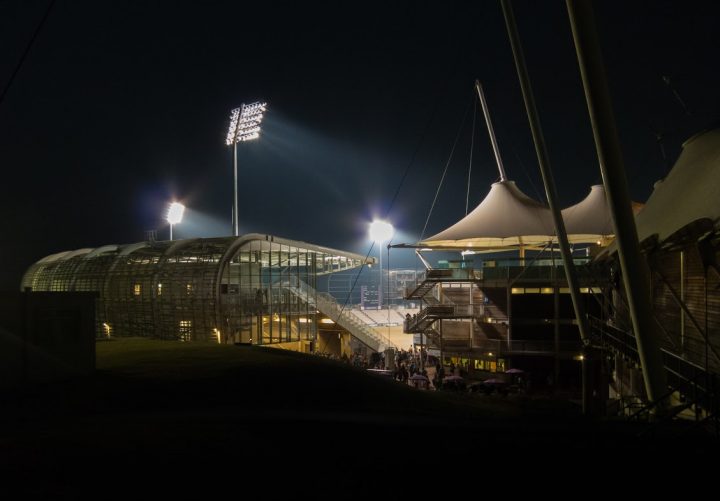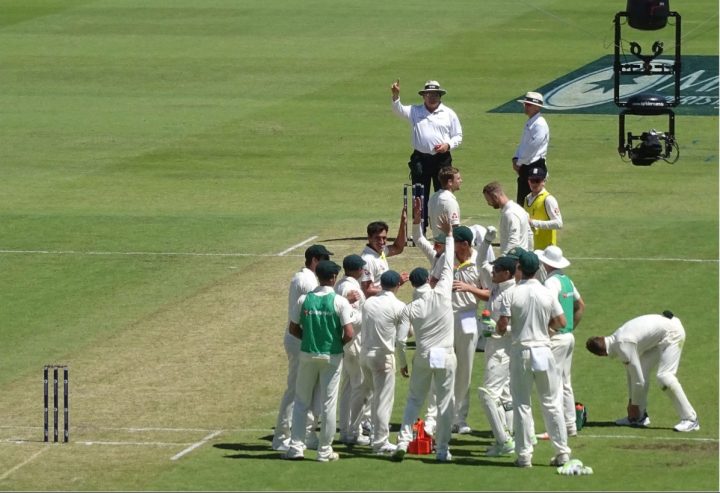During the second test at Lord’s, David Gower tried to make the most of an interruption in play by talking to the MCC’s Head of Cricket, and former England one-cap wonder, John Stephenson. Although I was hoping for a debate about why Stephenson looked like he’d just stepped off stage with Franz Ferdinand (his immaculately gelled hair and well tailored suit unintentionally gave him something of an indie retro look) the topic of conversation was actually day-night tests – a subject close to Stephenson’s heart.
Most purists agree that test cricket is fine, but unfortunately attendances around the world suggest otherwise. A number of cricket’s establishment believe that day-night matches are a viable way of modernising the game, raising interest, and getting fans through the turnstiles. Sceptical? You’re not the only one. Gower looked less convinced by the proposal than by Botham’s attempt to compare Hussain’s appearance to a green mallard. Poor old Nasser – his beak isn’t that big, honest.
One of the problems confronting Stephenson and the advocates of day-night tests is a lack of understanding about what the concept actually entails. Perhaps Gower was too quick to dismiss the idea? We’ll look at a few of the arguments.
A purist’s argument – the cons
Rewind to the 1980s, 1970s, 1960′s. Any decade you like, in fact. Imagine the murmurs of ridicule and suggestions of insanity if someone mentioned the idea that in a few years’ time test cricket would have developed into a day/night contest. Even now, the notion seems absurd and misdirected. Surely only one-day and Twenty20 cricket could take place under the stars and in front of a relaxed crowd of businesspeople and young kids who had just finished a day of hard graft in the office or classroom? It seems all the glitz and glamour has gone to people’s heads.
Test match cricket is a game of pure skill, subtlety, mental strength and fascinating complexity. It is a game that has always been played in the light of day, starting in the morning, and concluding as the sun makes its descent beneath the horizon. In fact, not only is sun a preferable part of Test cricket’s makeup, but the slightest hint of cloud or rain casts doubts in the mind of the umpires, whose first thoughts regard the health and safety of the players on the pitch.
Ian Botham has a thing or two to say about the levels of common sense that often avoid our ‘elite panel’ in the modern-day game, although Beefy rarely shies away from any debate or confrontation. Regardless of Botham’s over-critical nature, he has a point. During the fourth day of the Lord’s Test match between England and Sri Lanka, umpires Billy Doctrove and Rod Tucker took the players from the field in light that was deemed too dangerous to continue playing in. Five minutes later, and play resumed in conditions that weren’t drastically dissimilar to moments earlier.
While there wasn’t a great deal of play lost, the perception of doubt and the continued inconsistency of decision-making in so-called ‘bad’ light leaves me wondering how on earth day/night Test cricket could ever work. After all, even with the floodlights on full glow, Doctrove and Tucker were worried about the state of play.
According to John Stephenson, MCC’s Head of Cricket, day/night Test matches can prevail providing the correct colour ball is used. That colour is pink. He says: “it is well known that the white ball deteriorates more quickly than the red. We anticipate that batsmen will find the pink ball easier to see, particularly in poor light”, thus making it a seemingly perfect candidate to replace the red cherry in what would be a unique and innovative form of the game.
Having been tried and tested in various environments over the last eighteen months, the pink ball has received glowing reports from all quarters. Easier to see, less scuffing, no outstanding discrepancies between the red and white balls. But it isn’t the colour of the ball that concerns me. My question is: how can we play day/night test cricket when even with floodlights on and 80mph dobbers operating, umpires deem conditions to be threatening to the players’ safety?
If day/night test cricket is to work, there would have to be a dramatic alteration in the mindset of umpires, as well as the rules in order to sustain play in darkness. Would it take the possibility of going off the field for bad light completely out of the equation? What happens when we hit twilight at 8.00 or 8.30pm on a fine summer’s evening? Will the setting sun cause batsmen problems like it has done at grounds such as Derby who had to implement plans to rotate their pitch around for this very reason?
Not only that, but the whole tradition and history of the game will be turned on its head. It seems a great shame to even be talking about the idea of day/night test cricket particularly as Twenty20 and one-day cricket provide such an approach already.
Furthermore, what makes the authorities believe that day-night tests would actually serve their primary purpose i.e. increasing attendances and raising gate revenue? Presumably matches would start at approximately three o’clock in the afternoon, so working folk would still have to take time off. If they’re going to do that, wouldn’t they prefer to take the whole day and watch test cricket at its traditional starting time of 11am?
And what about those who want to attend after work or school? I can’t see many people forking out £60 for a ticket when they’re going to miss three hours of play. Then there’s the devoted fans who travel large distances to watch cricket. Not everybody lives near to a test venue. If play finished at 9.30pm, some people aren’t going to get home until after midnight. That’s bound to put people off. Like David Gower, I’m afraid that I’m a sceptic. Test cricket at night is about as viable as astronomy during the day.
A moderniser’s attitude – the pros
If it aint broke don’t fix it. But if it is broke then drastic action is required. Yes, night-day cricket does sound a little bizarre. And yes, it does fly in the face of cricketing convention. But we’ve got to do something. If we try day-night cricket and it fails, so what. We haven’t lost anything. But if it works, we might have found a way to reinvigorate the longer form of the game. Surely it’s worth a punt?
Nobody is suggesting that all test cricket would be played under floodlights. There would still be a place for the traditional 11am starts. Some people worry that bad light would be an issue – but it really wouldn’t. Day-night tests would be played with a luminous pink ball, the easiest colour to see, with dark sightscreens in the background. Visibility would therefore be much improved. They tried it in the MCC versus Nottinghamshire curtain raiser in Dubai in April. By all accounts the experiment was a success.
Day-night cricket also actually increases the chances of the paying public getting a full day’s play. When it gets to five o’clock in the evening, and the umpires start getting twitchy about the light, they’ll simply turn the floodlights on earlier. No play would be lost. What’s more, they can put the lights on any time they like – even at 3pm if necessary. The pink ball and dark sightscreens means it wouldn’t be a problem.
At the current time, floodlights are used in test cricket purely to extend play temporarily in borderline light. Once the floodlights take over from the natural light, the umpires are duty bound to go off. This is because the red ball has no luminosity whatsoever, and it’s difficult to pick up when the ball begins to cast a shadow – therefore it does get dangerous, regardless of what Sir Ian in his infinite wisdom says.
Cricket is an entertainment business. If test cricket was played with a pink ball and dark sightscreens, the paying public wouldn’t get short-changed by officious umpires with a light meter fetish ever again. If test venues are going to charge upwards of £50 for a ticket, then everything must be done to ensure they get value for money.
At the current time, only Lord’s and the Oval test matches are regularly sold out. The ECB seem determined to take test cricket around the counties – yet outside of the capital, the public seems a little apathetic. Why not give day-night test cricket a go? Even if the crowds are sparse in the first session, as they were in Cardiff a fortnight ago, there’s a good chance the crowd will build up later in the day. Venues could even sell cut-price tickets to those who turn up at the gate after work.
Twenty years ago, I would have cringed at the thought of cheerleaders dancing on platforms whenever a four or a six is scored. And I’d probably have punched anyone who proposed playing pop-music in-between overs – especially when it’s Atomic Kitten crucifying 10cc’s classic Dreadlock Holiday.
However, things like this are now part and parcel of ODIs – and all the feedback suggests they’ve become an integral, and popular, feature of watching live cricket. Are we going to live in the past, like a certain Mr Gower, or get down with the kids, like ‘Franz Ferdinand’ Stephenson. If we want test cricket to have a future, there’s only one option I’m afraid.
Let us know your thoughts.
George Curtis & James Morgan










Hmmm! Surely the arguments for day/nighters at test level ignore the somewhat unpleasant fact that – like it or not – much of the income at modern test grounds is corporate. The day out in a corporate sponsor’s box is a major part of the modern test experience and there is great deal of money at stake.
I’m not sure that 3:00pm starts would fit at all well with accepted notions of corporate hospitality. The 11:00am start allows everyone to get a bit of a lie-in and still pitch up in time for complimentary snifters before a ball is bowled – a decent lunch and then tea later during which the racing can be watched on the TV in the box – and finally home at about the usual time with the feeling of having put in a decent day’s work.
3:00pm to 9:30pm? That doesn’t work at all. For a start you’d have no excuse not to go to the office first, then you’d have had lunch before you even get to the ground, and there would always be the risk of getting caught up in something important that stopped you getting away in time for the start.
No, no,no – that wouldn’t work at all!!
If something is good enough it will survive if not it won’t. Turning it to a T20-like circus won’t help at all. I rather see it dying in dignity and have people believe that ODI or T20 is “real cricket” then following every brain fart that is out there so “safe the game”.
If the ground authorities at Lords wanted to continue in bad light then they would ensure that there were proper sight screens at both ends. However at the pavilion end the members of MCC must be able to see the cricket without moving from a usually drunken stationary position. Evening Test Matches will mean that the plebs from the provinces can pay exorbitant prices to attend plus even more extortionate hotel prices to stay in town. This doesn’t add up.
Perhaps this would work in parts of the world where it is hot in the day and the evening is more pleasant, but on a cloudy evening in England ? No way. The corporate argument, as well as being amusing, is also a strong one. It surprises me that more tests don’t run Wednesday to Sunday, guaranteeing 3 days of corporate and the chance to fill the ground on the fifth day if the game lasts.
I was listening to Richard Johnson, former England seamer and current Middlesex bowling coach, being interviewed about the pink ball, and whilst much of what he said was positive; easy to see, less scuffing etc. He also said that there was a negative; there was very little movement either in the air or off the pitch for the seam bowlers. This is a problem.
We don’t want cricket of any format to turn into a batsmen-dominated game. We all know how dull it gets when one side scored 600, and the other follows it up with 500-5d and the game is drawn after five pointless days of cricket. We still want bowlers to have as much chance as batters of dominating a game. Afterall, it’s more entertaining when bowlers are on top.
I’m afraid I’m a purist, and always will be. Therefore, the thought of day-night Tests makes me feel ill. Don’t do it it our wonderful game.
Does the volume of fans through turnstiles matter? Ticket sale revenue must dwarf in comparison to TV money, so I can’t see any arguement regarding the ‘health and viability’ of the game here sorry.
If you want to look at falling attendences then you need to address 1) the cost of a ticket is prohibitive (eg: £90+ per day at the Ashes at Lords), 2) the woefully inadequate experience and even more prohibitive costs within the grounds.
Totally agree re: the price of tickets Paul. Gate revenue is still important though – if not to the ecb coffers (as yes, tv money is much more lucrative) then to the hosting county. If people don’t turn up at the ground then the hosts make huge losses
Let’s give it a try. Remember first and foremost that cricket is entertainment and needs to evolve and adapt to meet a changing audience’s expectations. “Tradition” is cited too much in cricket as a convenient excuse to resist change.
Most people are at work for 3 out of 5 days of a Test so miss out on ball by ball coverage in any form – having at least one, maybe two, sessions in the evening would give them the opportunity to watch it live or on TV after work. As you point out, offering cut-price tickets for one or two sessions may help to fill the ground and be a good “taster” for people who haven’t seen a live Test before – if they like what they see, they may come back for a whole day next time.
Finally, anything that ends the daftness of going off for bad light can’t be a bad thing.
If we stick with tradition the game would only be played by shepherds as the sun goes down over the fields with a crook and stall! The game has been evolving for years. Our grandfathers (hmm shepherds and our fathers make me sound like I am a fanatic) would have probably been moaning about the first ODI all those years ago. The man derided was Kerry Packer but he is probably the daddy of the modern game.
Time moves on and Test cricket will move with it. Some changes will be for the better, others won’t. Hopefully the administrators will quickly weed out the bad ideas (hmmm perhaps not). But let’s face it, money rules.
I say let’s give it a whirl and see where we go, I think they preserve the essence of test cricket even in the dark!
MHA here. Thanks everyone for your very interesting two comments.
On the subject of tradition…in one sense heritage and custom give cricket its richness, but the only worthwhile traditions are those which have a functional or aesthetic merit in their own right. For example, I believe that playing in whites is preferable to coloured clothes, for the simple reason that they look nicer. But by the same token it was right to abolish, in the 1960s, the distinction between amateurs and professionals, because the distinction was unfair and harmful, albeit traditional.
Quite a few of cricket’s traditions are more recent inventions than you might expect. To return to the wearing of whites: that only dates back, as I understand it, to about 1880. Before then, players wore pretty much what they liked.
On the subject of ball colour – it’s often seemed to me that of all the colours a cricket ball could be, red is a poor choice, because it’s hard to see. As spectator, I often lose the ball againt the backdrop. With my village team, we often use a white (and occasionally orange) ball when we play at grounds with no sightscreen and where there’s a lot of greenery around. It’s so much easier to see.